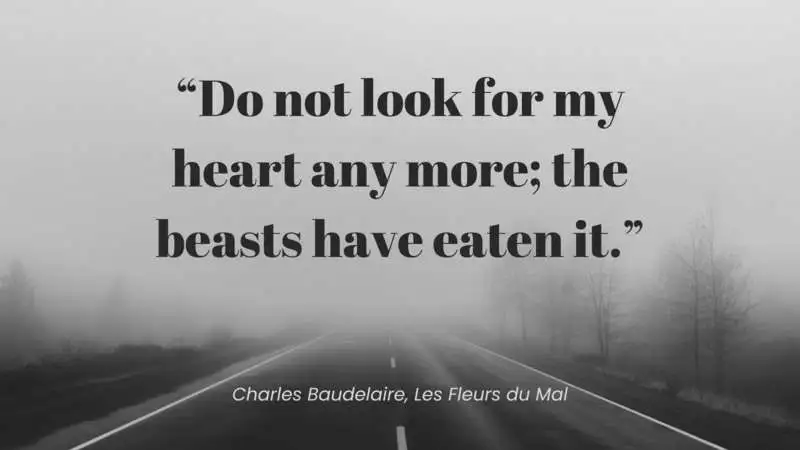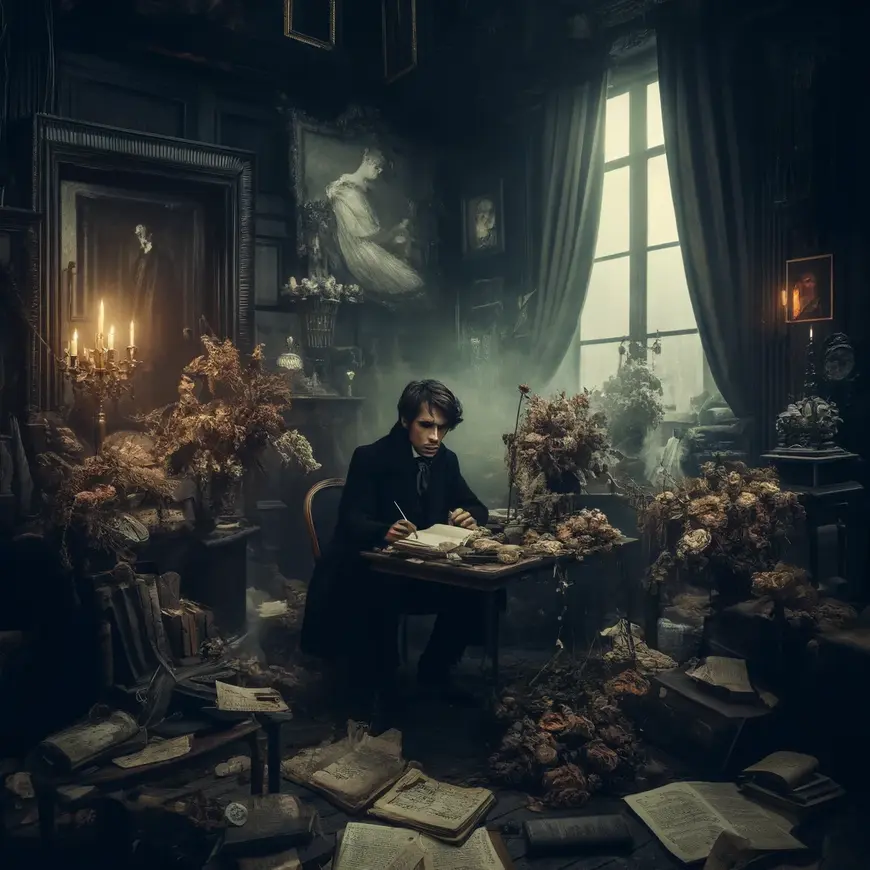A Symphony of Dark Beauty – A Review of “The Flowers of Evil” by Charles Baudelaire
Unveiling the Elegance of Darkness – A Deep Dive into Charles Baudelaire’s “The Flowers of Evil”
In the realm of poetry that delves into the depths of human emotions, Charles Baudelaire’s “The Flowers of Evil” emerges as a mesmerizing tapestry of beauty and darkness. With verses that dance between despair and ecstasy, Baudelaire weaves a narrative that invites readers to explore the intricacies of the human soul and the eternal struggle between light and shadow.

A Garden of Enchantment: The World of “The Flowers of Evil”
Imagine a garden where the flowers bloom with both exquisite allure and haunting melancholy. “Les Fleurs du mal,” which translates to “The Flowers of Evil,” introduces us to a collection of poems that paint a vivid picture of human experience. Baudelaire’s verses traverse a landscape of love, despair, ennui, and the fleeting nature of beauty.
The setting of “The Flowers of Evil” becomes a tapestry of emotions, a canvas upon which Baudelaire captures the raw essence of existence. His narrative reflects the complexities of the human psyche, as he invites readers to wander through the corridors of human emotion.
A Gallery of Emotions: Poems in the Spotlight
The heart of “The Flowers of Evil” lies within its poems, each a window into the intricate chambers of the human heart. Baudelaire’s verses are an exploration of the human condition, a mosaic of emotions that reflect the myriad facets of existence. From the sensual allure of “The Flowers of Evil” to the profound introspection of “Spleen and Ideal,” Baudelaire’s poems encompass a range of experiences.
The themes of love and desire are recurrent threads that weave through the collection. Baudelaire’s portrayal of romantic entanglements explores the intoxicating dance of attraction and the poignant yearning for connection. However, his exploration of love is far from conventional; it’s a journey through the shadows of passion and the complexities of human relationships.
Themes of Beauty and Decay: Insights Explored
The work delves into themes that resonate deeply with the human experience. The interplay between beauty and decay is a central motif, reflecting Baudelaire’s belief in the inherent duality of existence. His verses acknowledge the transient nature of beauty and the inevitability of decay, inviting readers to contemplate the fragility of life’s pleasures.
Baudelaire also delves into the theme of ennui, a sense of profound dissatisfaction with the world. His portrayal of this emotion captures the restlessness that often accompanies the search for meaning in a world that appears both captivating and indifferent.
A Symphony of Words: Baudelaire’s Writing Style
Charles Baudelaire’s writing style is a blend of elegance and darkness, a symphony of words that mirrors the complex interplay of emotions. His language is rich and evocative, as he crafts verses that are both exquisite and raw. Baudelaire’s imagery is vivid, painting scenes that linger in the mind long after the reading is done.
The collection’s structure is deliberate, reflecting the ebb and flow of human emotions. Baudelaire’s poems are a journey through the highs and lows of existence, an exploration of the human soul that invites readers to contemplate the depth of their own feelings.

Notable Quotes from “The Flowers of Evil” by Charles Baudelaire
- “The poet is like this prince of the clouds / Who haunts the tempest and laughs at the archer; / Exiled on the ground, in the midst of the jeering crowd, / His giant’s wings prevent him from walking.”
- Explanation: This quote, from the poem “The Albatross,” compares the poet to an albatross, a majestic bird that soars gracefully in the skies but becomes clumsy and mocked when on the ground. It symbolizes the poet’s lofty vision and creativity, which are often misunderstood or ridiculed by society.
- “You, my sorrow, and my joy, / You, my health and my disease, / You, my night and my day! / You, my everything, my one and only!”
- Explanation: From the poem “Hymn to Beauty,” this quote captures the complex duality of beauty and love, portraying them as sources of both profound pleasure and deep pain. It reflects Baudelaire’s fascination with the intertwining of joy and suffering in human experiences.
- “Hypocrite reader, my fellow, my brother!”
- Explanation: This line from the preface “To the Reader” addresses the reader directly, accusing them of sharing in the same vices and hypocrisies that Baudelaire explores in his poetry. It challenges the reader to confront their own moral failings and the universal nature of sin.
- “There is a marvelous place, a vast and infinite place, / Where all that is possible is both strange and beautiful.”
- Explanation: This quote from “Invitation to the Voyage” invites the reader to imagine an idealized, dreamlike world where beauty and strangeness coexist harmoniously. It reflects Baudelaire’s yearning for escape from the harsh realities of life and his quest for an idealized form of beauty.
- “The Devil’s hand gently guides us / Through the dark, odorous mire.”
- Explanation: From the poem “The Litanies of Satan,” this quote depicts Satan as a figure who leads humans through the corruption and moral decay of the world. It underscores Baudelaire’s exploration of evil and temptation, and the allure of the forbidden.
Trivia Facts about “The Flowers of Evil”
- Publication and Controversy: “The Flowers of Evil” was first published in 1857. Upon its release, the French government prosecuted Baudelaire and his publisher for obscenity. Six of the poems were banned for their explicit content and themes of eroticism and moral decay. Baudelaire was fined, and the banned poems were not republished in France until 1949.
- Title Significance: The title “Les Fleurs du mal” translates to “The Flowers of Evil,” signifying the juxtaposition of beauty and corruption. Baudelaire aimed to explore the beauty that could be found in even the most depraved and sordid aspects of life, thus elevating the concept of evil to the level of art.
- Influence on Modern Poetry: “The Flowers of Evil” is considered a cornerstone of modern poetry. Its themes, style, and innovative use of symbolism had a profound impact on later literary movements, including Symbolism and Decadence. Baudelaire’s work influenced many poets, such as Paul Verlaine, Arthur Rimbaud, and Stéphane Mallarmé.
- Structure and Themes: The collection contains 126 poems (after the removal of the six banned ones) organized into six sections: “Spleen and Ideal,” “Parisian Scenes,” “Wine,” “Flowers of Evil,” “Revolt,” and “Death.” The poems explore themes such as beauty, decay, love, melancholy, the passage of time, and the quest for transcendence.
- Baudelaire’s Struggles: Charles Baudelaire faced many personal struggles, including financial difficulties, ill health, and addiction. His tumultuous life experiences deeply influenced his poetry, contributing to the themes of despair, existential angst, and the search for meaning in a seemingly indifferent world.
A Timeless Elegance: Relevance Today
While “The Flowers of Evil” emerged in the 19th century, its themes of beauty, darkness, and the complexities of human emotion remain relevant in the modern world. In an age marked by the pursuit of pleasure, the transient nature of beauty, and the perennial struggle to find meaning, Baudelaire’s exploration of these themes offers a timeless perspective.
The tension between light and shadow, pleasure and pain, is a universal experience that resonates across cultures and generations. Baudelaire’s verses serve as a reminder of the delicate balance that defines the human condition, encouraging readers to embrace life’s contrasts and to find beauty even in its most enigmatic corners.
Final Thoughts on “The Flowers of Evil” : Embracing the Ephemeral
“The Flowers of Evil” is a poetic masterpiece that invites readers to journey through the garden of human experience. Charles Baudelaire’s verses are not mere words; they are windows into the soul, reflections of the beauty and darkness that coexist within us all. Through his exquisite language and profound insights, Baudelaire captures the essence of existence – the fleeting moments of joy, the profound depths of sorrow, and the eternal struggle between light and shadow.
As readers immerse themselves in the collection, they are encouraged to embrace the ephemeral nature of life, to savor its pleasures while acknowledging its impermanence. “The Flowers of Evil” stands as a testament to the power of poetry to capture the complexities of the human heart and to offer solace in the recognition that even amidst the darkness, there exists a poignant and haunting beauty that lingers long after the final verse.
More Reviews of Works by Baudelaire
Le Spleen de Paris (by Baudelaire)
A Deep Dive into Urban Melancholy: A Review of “Le Spleen de Paris” by Charles Baudelaire My Thoughts on Le…
the Canvas of Urban Existence: “The Painter of Modern Life” by Charles Baudelaire Charles Baudelaire, a poetic luminary of the…

